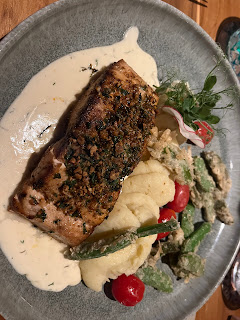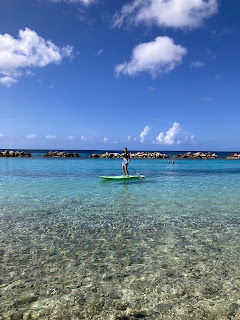I competed in my very first Winterlude triathlon (21 kilometres of ice skating, running, and cross-country skiing) in freezing -31 windchill, managed to not get frostbite, and then a few days later hopped on a plane for a hot vacation in Curacao, a tropical island off the coast of Venezuela.
We stayed here for a good chunk of this month, ostensibly to celebrate any number of milestones I’ve been grateful for lately: finishing my PhD, turning 40, getting a promotion at work, making one of the competitive roller derby travel teams. But it was also about allowing myself a restful break after working pretty hard last year, before moving on to what I feel like will be an exciting new chapter in my life.
At any rate, Curacao is its own geography, different from all of these places I had been before. Until I became an adult, the only thing I even know about Curacao was the distinctive blue Curacao drink that a friend in high school once got very sick off (which kind of turned me off that drink for decades).
For one thing, it’s not exactly an impoverished country. Throughout my trip I was impressed by the country’s infrastructure. The island may have a tiny population, but they have clean drinking water, a strong tourism sector, fast internet, low crime rates, clean streets, far better than some parts of Canada. Also, the prices of a developed country. It took me some time to adjust to the cost of restaurants and taxis, but it was well worth it. The low crime rates meant that I felt safe wandering around the neighbourhoods and parks on my own, and it helped me really enjoy the island.
Our accommodations featured a cozy little terrace framed by palm trees, overlooking the marina by the aquarium where a couple of big boats were docked. I spent much of my stay in a bikini. Not necessarily because this is how everyone dresses around here. It’s just that it was very hot all day long, every day, especially for this Canadian body after having been training for a winter triathlon, and maybe once you turn forty you stop caring about what people think about your body.
The ocean was perpetually an idyllic temperature cool enough to offer a welcoming respite from the humidity, rather than feeling like a warm bath or being just a bit too cold to require some bravery to take the plunge. The salt content made extra buoyant in the water, injecting me with a false sense of over-confidence about my swimming abilities. Floating in the ocean felt like a soothing massage for my sore body, battered from all the roller derby practice and skatepark slams.
The water is exactly the right shade of turquoise that all beach tourists are obsessed with for their photos, but it’s also clear enough that you can see the sea floor in the bay and all the various fishies hanging out there. My daily route to the ocean beach cut through the dive shop, where I bought a diagram from the dive shop showing the various different kinds of fish you could find by the coral in this area.
Rob and I spent our days swimming in the ocean and trying to name all the tropical fish we saw. I normally swim like a cat; reluctantly and resentfully, trying to keep as much of my body above water. I usually would prefer not to know what creatures are in the water with me, but I slowly got over my squeamish nature on this trip and learned to hold my breath and swim underwater to look at all the fish, which thankfully did not include any sharks, although Rob says he saw some barricudas and puffer fish. On the our last day, my friend S got attacked by a fish that bit her on the leg and drew blood. We never quite figured out what it was – we were told it was definitely not a scorpion fish because she’d already be dead, but otherwise, we were stumped. I’m glad this happened on our last swim because I probably wouldn’t have enjoyed swimming in the ocean so much.
We certainly spent a lot of time hanging out on Mambo Beach, but I also enjoyed seeing other parts of the island. One morning we went in search of Dutch pancakes in the capital city of Willemstad, a beautiful picturesque town, lively and colourful but clean and friendly. The place where we were seeking Dutch pancakes were on the side of the water. We took the free ferry across, because the pontoon bridge had swung open to let a massive ship pass through. This wasn’t a cruise ship this time, but instead, to my surprise, a Canadian patrol vessel called the Harry DeWolf, which I thought was an Arctic icebreaker but there definitely wasn’t any ice here.
Later on at a bar, I ran into some Canadian officers who were working on the ship. I asked them what they were doing here, rather than the Arctic. They said they couldn’t disclose the exact details of their mission, but they assured us that the ship was very well equipped.
I particularly enjoyed skating around Willemstad, because it allowed me to cover more areas and see more sights. The historical Kurá Hulanda Village was a bit more challenging to skate around because it was all cobblestone.
I loved exploring the streets and buildings, and even an empty lot which had a lovely view of the ocean. I stopped to take a picture of it, when a van stopped in front of me and a driver climbed out. I found out that the lot is a popular spot for drivers to stop to pee. I did not take a photo of that.
We went for a hike around the Jan Thiel salt pan and got to admire all sorts of plants and animals. Cactus everywhere. There were little yellow bellied birds, barely larger than a hummingbird, that the locals called sugar thieves, because they love to steal the sugar packets from your tea. I saw two parakeets, who are always in pairs - is just one called a keet? I have never seen them outside of a pet store before.
There were countless flamingos hanging around the salt pan. It was like those plastic flamingos people put on their lawns to celebrate birthdays – and S and I were celebrating our 40th birthdays – but this was much better, because they were real! (I couldn't get any good photos of them though because they were farther away)

It suddenly began to pour in the middle of our hike. That’s when I learned that the island has these manchineel trees which are one of the most toxic trees in the world. It’s not just about trying not to eat their death apples. Just standing underneath one of these trees is dangerous, because the rain mixed with the toxins of the tree dripping on your skin could cause instant blistering. The Spanish explorers had brought these to the island to fight off their enemies, which totally tracks.
Anyway, once we escaped and survived the death apples, we were totally fine with the rain, which actually helped cool us down.
On S’s actual 40th birthday, we got to check out the national park, guided by a larger-than-life driver named Lisa driving an equally outrageous converted school bus that had been painted in bold reggae colours. She had heard that it was S’s birthday, and greeted us at our hotel blasting “Happy Birthday” and waving a bottle of sparkling wine at us with four wine glasses. Suddenly I found myself a little tipsy amidst the festivities… at eight o’clock in the morning, on a school bus.
Lisa was an expert stunt driver. She could drive the bus down streets so narrow, I could reach my hand out to touch the barbed wires guarding the gates of houses if I wanted to (I did not want to). She warned us again about the death apple drives then drove us to the Hato caves.
Afterwards, she drove us to Playa Piskado, famous for the juvenile sea turtles that swim with you in the water. I also saw gorgeous pelicans on the pier, and a little lizard with the brightest turquoise tail.
We had lunch at at a restaurant on another beautiful beach, Playa Porto Mari, where they served the famous Williburger, a delicious goat burger that Rob had been meaning to try while on the island.
At one point, I saw a literal chicken crossing the road. I forgot to ask it why.
It was pretty much a perfect vacation. I spent a lot of time at Marie Pampoen Park, where, yes, there was a skatepark, but also playgrounds and picnic spots by the ocean, where a lot of locals took their walks and played games. We passed our days relaxing on the sunny beach, eating pastechis and drinking Brasa beers and generally enjoying not being cold like everyone else back at home in Ottawa. The nice thing is that I feel like I’m at a good point in my life. I enjoy my work and I have a rich thrilling life after work with skating and music and inspiring people. I don’t feel compelled to escape from my normal routine. Instead, I can let myself just enjoy vacations like this for what they are, with a calmness from the knowledge that at age forty, I feel like I’m doing all right. The locals have a term, dushi, which they use to describe everything awesome. That’s how it felt here.































